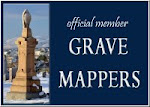Have you ever wanted to peek in somebody's diary? Here is your chance. The following are three excepts from my diary/journal of a trip I took to Western New York last year.
I went to look for my family at the Old Catholic Cemetery but they weren’t there. That is a cemetery that looks like an old cemetery. It is on a hill a mile from the church. As you stand there you can see over the town. It is not taken care of. Many stones are tilted this way and that. Most stones are lying flat, with the inscription side buried in the ground. There are only a few that are standing upright. I read a transcription of the cemetery that was done in 1932. The author said “it is a well kept cemetery”. Too bad it is not now. There are a couple of homes across the road. They are nice homes that are surrounded by very large yards. I thought to myself: “Too bad someone there doesn’t make a hobby of keeping the cemetery beautiful”. In all honesty, I probably wouldn’t either. I would want to but I would try to get my husband, Dave, to do it instead. I would rather write about the people that are buried there. And sit next to their graves and talk to them.
Later I learned that Mary and John Carroll are buried in another cemetery about a mile from town. It is called the Assumption Church Cemetery. The locals refer to it as “Irish Hill.” Mostly the canalers are buried there. They came to work on the Genesee Valley Canal. Many also worked on the railroad. In the cemetery there is a monument for the Ryan family that illustrates everyone on Irish Hill:
“In memory of the Irish who populated this area during the building of the
bridge and the Genesee Valley Canal, bringing their faith with them.”
A couple pages later….Then we went up to the new Catholic cemetery. When John first told me about it he said “bring your boots and we will climb Irish Hill”. I had in my mind that we would have to climb some old hill that was over grown with vegetation, but it was a wonderful walk. John had been having fun with me. In fact the whole area is very pretty. This cemetery was started after 1901 when the other cemetery became too full. It is very well kept; all the stones are very pretty. Many graves had flowers on them showing that someone still honors them. My new friend showed me the graves of his parents and his other family graves. They were close to my family by several yards. They probably knew each other. But of course they knew each other. This was a small town, they went to the same church, they were all Irish.
The Carroll stones are nice, embellished monuments. I asked if they had some money for such stones. John said it didn’t matter if they had money or not, these Irish folks would have a nice stone. I was wondering where John and Sarah were buried. I assumed it would have been in Castile where they had to live after the Park took their house away. I was glad to see that they were buried right next to their family. John was buried next to his wife, Mary, to whom he was married to for a short time. The church records don’t reflect their marriage. Perhaps they were married in her hometown. I don’t know where she is from or her maiden name. She died in 1918; we thought perhaps she died in the flu epidemic.
I felt so close to them there. I have tried to learn about them from official records but to see their graves mean a lot. Although they have been gone for a long time, it seemed like something concrete to verify they did once live makes it real.
Another day, several pages later...........
I took Sheila up to the old Catholic Cemetery which looks like a real old cemetery, the kind you see in movies about ghosts. The stones are falling this way and that, and many have simply fallen flat to the ground. Then we went up to Irish Hill. I wanted to visit the Carrolls and McCarthys again. Sheila got out with me and took my picture at their graves. I introduced Sheila as my new family and the Carrolls and McCarthys as my old family. In some weird way I felt like we all were bonded. And we are all family through marriages. And that is for another story.
My work was done in Portageville, New York. I didn’t know what else I could do so we took a quick spin around town once again then got on the road to go home.
The town is a part of history now, just as though you closed a book. The people that built it, the canalers, railroad men, saloon and inn keepers are all on Irish Hill. No matter how much money you have to spend it will never be the same as when the Carrolls and McCarthy’s lived there.
















